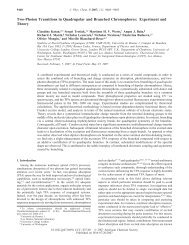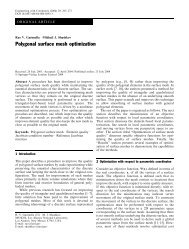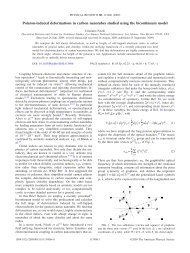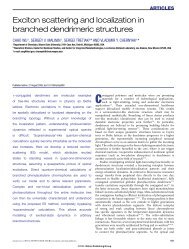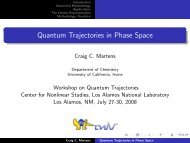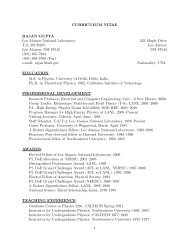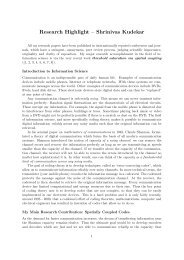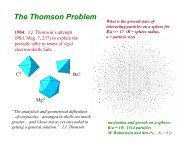exciton-phonon coupling and Huang-Rhys factors - Center for ...
exciton-phonon coupling and Huang-Rhys factors - Center for ...
exciton-phonon coupling and Huang-Rhys factors - Center for ...
You also want an ePaper? Increase the reach of your titles
YUMPU automatically turns print PDFs into web optimized ePapers that Google loves.
PRL 98, 037405 (2007)<br />
Determination of Exciton-Phonon Coupling Elements in Single-Walled Carbon Nanotubes<br />
by Raman Overtone Analysis<br />
Andrew P. Shreve, 1 Erik H. Haroz, 1 Sergei M. Bachilo, 2 R. Bruce Weisman, 2<br />
Sergei Tretiak, 1 Svetlana Kilina, 1 <strong>and</strong> Stephen K. Doorn 1, *<br />
1<br />
Los Alamos National Laboratory, Los Alamos, New Mexico 87545, USA<br />
2<br />
Department of Chemistry, Rice University, 6100 Main Street, Houston, Texas 77005, USA<br />
(Received 20 July 2006; published 19 January 2007)<br />
Raman excitation profiles are obtained <strong>and</strong> compared <strong>for</strong> carbon nanotube radial breathing mode<br />
(RBM) fundamental <strong>and</strong> overtone vibrations <strong>for</strong> 5 specific chiralities. Fitting of the Raman excitation data<br />
is per<strong>for</strong>med using Raman trans<strong>for</strong>m theory. The <strong>Huang</strong>-<strong>Rhys</strong> <strong>factors</strong> obtained from the modeling are<br />
directly related to the magnitude of the RBM <strong>exciton</strong>-<strong>phonon</strong> <strong>coupling</strong> element, which is shown to be in a<br />
weak <strong>coupling</strong> limit. The values of <strong>exciton</strong>-<strong>phonon</strong> <strong>coupling</strong> strengths <strong>and</strong> the possible role of revealed<br />
non-Condon effects are in agreement with quantum-chemical modeling.<br />
DOI: 10.1103/PhysRevLett.98.037405 PACS numbers: 78.67.Ch, 63.20.Ls, 63.22.+m, 78.30. j<br />
Carbon nanotubes are important low-dimensional materials<br />
with a variety of physical behaviors, of both fundamental<br />
<strong>and</strong> applied interest, in which electron-<strong>phonon</strong><br />
<strong>coupling</strong> can play a significant role. High electron mobility<br />
in carbon nanotubes is one feature that makes them attractive<br />
<strong>for</strong> nanoscale electronics applications. More recently,<br />
with the demonstration of light emission from semiconducting<br />
nanotubes [1], photonic <strong>and</strong> electro-optic applications<br />
[2,3] have been envisioned. Both transport <strong>and</strong><br />
optical phenomena are impacted by the magnitude of<br />
electron-<strong>phonon</strong> <strong>and</strong> <strong>exciton</strong>-<strong>phonon</strong> <strong>coupling</strong>. Phonon<br />
scattering results in significant loss in mobility at high<br />
applied fields in nanotube electronic devices [4]. Phononassisted<br />
absorbance features observed in photoluminescence<br />
excitation spectra [5,6], <strong>and</strong> <strong>phonon</strong> sideb<strong>and</strong>s observed<br />
in photoconductivity spectra [7] demonstrate the<br />
importance of <strong>exciton</strong>-<strong>phonon</strong> <strong>coupling</strong> <strong>for</strong> optical processes<br />
in nanotubes. A number of theoretical ef<strong>for</strong>ts have<br />
recently appeared to describe these results [8,9].<br />
Pronounced chirality dependent effects on nanotube radial<br />
breathing mode (RBM) Raman scattering intensities have<br />
also recently been observed [10–12], <strong>and</strong> shown to arise<br />
from chirality dependences appearing in the <strong>exciton</strong><strong>phonon</strong><br />
<strong>coupling</strong> matrix element [13–16].<br />
Nanotubes have been considered to be weakly <strong>exciton</strong><strong>phonon</strong>-coupled<br />
systems in the past, but recent photoluminescence<br />
excitation (PLE) <strong>and</strong> photoconductivity results<br />
suggest that this may not be the case [5–7,17]. However,<br />
there have been no direct quantitative measurements of the<br />
magnitude of <strong>exciton</strong>-<strong>phonon</strong> <strong>coupling</strong>, <strong>and</strong> these recent<br />
studies were focused instead on the unexpected observation<br />
<strong>and</strong> description of <strong>phonon</strong>-assisted processes as an<br />
indication of the importance of the <strong>coupling</strong> in nanotubes.<br />
Thus, there exists a need <strong>for</strong> quantitative experimental<br />
determination of <strong>exciton</strong>-<strong>phonon</strong> <strong>coupling</strong> strength.<br />
The ratio of Raman fundamental to overtone intensities<br />
depends upon <strong>exciton</strong>-<strong>phonon</strong> <strong>coupling</strong> strength [18,19].<br />
In this Letter we fit Raman excitation profiles <strong>for</strong> RBM<br />
PHYSICAL REVIEW LETTERS week ending<br />
19 JANUARY 2007<br />
fundamental <strong>and</strong> overtones <strong>for</strong> several nanotube chiralities,<br />
using Raman trans<strong>for</strong>m theory [19–22]. This modeling<br />
yields the <strong>Huang</strong>-<strong>Rhys</strong> factor (S), which is commonly<br />
used to characterize linear vibrational <strong>coupling</strong> to electronic<br />
excitations through the difference between ground<br />
<strong>and</strong> excited state geometries. The <strong>Huang</strong>-<strong>Rhys</strong> factor can<br />
be related to the displacement between the minimum energy<br />
positions of harmonic vibrational potentials associated<br />
with ground <strong>and</strong> excited electronic states by the<br />
expression<br />
S 2 =2; (1)<br />
where is a dimensionless displacement expressed in<br />
p<br />
units of @= ! , with being the reduced mass of the<br />
vibrational coordinate. For comparison with <strong>exciton</strong><strong>phonon</strong><br />
<strong>coupling</strong> models other than displaced harmonic<br />
oscillators, the <strong>Huang</strong>-<strong>Rhys</strong> factor is related to an<br />
<strong>exciton</strong>-<strong>phonon</strong> <strong>coupling</strong> element Vep, defined here as the<br />
gradient (in dimensionless coordinates) of the electronic<br />
transition energy along the vibrational coordinate of interest,<br />
as<br />
S 1=2 V ep=@! 2 ; (2)<br />
where ! is the frequency of the given vibration (here the<br />
RBM).<br />
In molecular spectroscopy, Franck-Condon overlap <strong>factors</strong>,<br />
related to S, determine the probability of specific<br />
electronic-vibrational transitions that give rise to vibrational<br />
replicas in absorption <strong>and</strong> fluorescence spectra.<br />
Subsequently, S characterizes the strength of <strong>exciton</strong>vibration<br />
<strong>coupling</strong>, with values of S 0:1 interpreted as<br />
weak <strong>exciton</strong>-vibration <strong>coupling</strong>. In the current work, we<br />
determine <strong>Huang</strong>-<strong>Rhys</strong> <strong>factors</strong> <strong>for</strong> the second <strong>exciton</strong>ic<br />
transition (E 22) in 5 different nanotube chiralities belonging<br />
to the n m mod3 1 (referred to as<br />
‘‘mod2’’) group using fitting of experimental Raman profiles<br />
<strong>and</strong> also provide comparison to quantum-chemical<br />
0031-9007=07=98(3)=037405(4) 037405-1 © 2007 The American Physical Society
PRL 98, 037405 (2007)<br />
calculations. Exciton-<strong>phonon</strong> <strong>coupling</strong> <strong>for</strong> the RBM is<br />
found to be in a weak <strong>coupling</strong> regime.<br />
Raman excitation profiles were obtained with<br />
Ti:sapphire laser excitation in the region 700 to 850 nm<br />
on HiPco-produced carbon nanotubes suspended in sodium<br />
dodecyl sulfate solution, as described previously [10]. PLE<br />
spectra were obtained from similar samples on a J-Y Spex<br />
Fluorolog 3–211 (see Ref. [23]). An example of Raman<br />
spectra <strong>for</strong> the RBM region is shown in Fig. 1. Overtone<br />
spectra are significantly weaker than the fundamental, with<br />
frequencies almost exactly twice that of the fundamentals,<br />
indicating low anharmonicity. Nanotubes described by a<br />
specific (n, m) structural index may be unambiguously<br />
identified, <strong>and</strong> spectrally isolated, due to the known variation<br />
of RBM frequencies <strong>and</strong> transition energies with (n,<br />
m) [10,11,23]. Individual Raman spectra were deconvoluted<br />
using Lorentzian peak fitting of the RBM fundamental<br />
<strong>and</strong> overtone features. Peak intensities from the<br />
deconvoluted spectra, referenced against an external st<strong>and</strong>ard<br />
corrected <strong>for</strong> the ! 4 excitation frequency prefactor <strong>for</strong><br />
nonresonant Raman scattering, were then used to generate<br />
chirality specific excitation profiles shown in Fig. 2. In<br />
general, the ability to obtain high quality profiles <strong>for</strong> both<br />
the fundamental <strong>and</strong> overtone was limited by the level of<br />
noise present in the weak overtone region, but profiles<br />
suitable <strong>for</strong> our modeling approach were obtained <strong>for</strong> 5<br />
different chiralities.<br />
Modeling of Raman scattering intensities under various<br />
sets of assumptions in order to obtain in<strong>for</strong>mation on<br />
<strong>exciton</strong>-<strong>phonon</strong> <strong>coupling</strong> strengths is a well-developed<br />
field. Raman trans<strong>for</strong>m theory allows direct calculation<br />
of fundamental <strong>and</strong> overtone excitation profiles using, as<br />
input, a line shape function derived from the electronic<br />
absorption spectrum [19–22]. The implementation used<br />
here includes thermalization <strong>and</strong> non-Condon effects<br />
[19,22]. The latter introduce vibrational coordinate dependence<br />
into the electronic transition dipole through a power<br />
series expansion. Assumptions invoked in our modeling<br />
are (1) Raman scattering is treated at nth order in the time-<br />
Relative Relative Intensity<br />
150 200 250 300 350<br />
Raman Shift (cm -1 Raman Shift (cm )<br />
-1 )<br />
(10X)<br />
400 450 500 550<br />
FIG. 1. Fundamental <strong>and</strong> first overtone (inset) Raman spectra<br />
of the RBM region <strong>for</strong> 766 nm excitation.<br />
PHYSICAL REVIEW LETTERS week ending<br />
19 JANUARY 2007<br />
037405-2<br />
correlator or trans<strong>for</strong>m theory sense (but nonperturbatively<br />
in the <strong>exciton</strong>-<strong>phonon</strong> <strong>coupling</strong> [22]), where n 1 <strong>and</strong> 2<br />
<strong>for</strong> the fundamental <strong>and</strong> overtone excitation profiles, respectively;<br />
(2) the fluorescence excitation spectrum of a<br />
particular chirality nanotube is taken to provide an accurate<br />
measure of its absorption spectrum; (3) this spectrum<br />
corresponds to a homogeneous electronic line shape in<br />
the resonance Raman sense, consistent with recent observations<br />
[24]; (4) vibrational frequencies of the RBM are<br />
equal in the ground <strong>and</strong> excited electronic states, also<br />
consistent with recent calculations [25]; <strong>and</strong> (5) the RBM<br />
is separable from all other vibrations.<br />
The modeling procedure is as follows. PLE spectra are<br />
manipulated by background subtraction <strong>and</strong>, if need be,<br />
truncation, to remove excitation features associated with<br />
other nanotube chiralities having nearby emission wavelengths.<br />
If necessary due to truncation, then a smooth<br />
extrapolation to the baseline is added, <strong>and</strong> finally, a smooth<br />
curve is generated using a spline interpolation method<br />
(Fig. 2). This curve is used as the absorption spectrum,<br />
A ! , in the trans<strong>for</strong>m calculation.<br />
From A ! , the line shape function ! is calculated as<br />
1 Z 1<br />
! P d!<br />
1<br />
0 A ! 0<br />
! 0 ! 0 iA !<br />
! ! ; (3)<br />
where a principal value integral is taken. Then, the fundamental<br />
Raman excitation profile is<br />
F ! KS! ! ! v 3 nv 1<br />
j1 C ! 1 C ! ! v j 2 ; (4)<br />
where K is a numerical constant, S is the <strong>Huang</strong>-<strong>Rhys</strong><br />
factor, ! v is the energy of one vibrational quantum, n v is<br />
the average thermal occupation number <strong>for</strong> a mode of<br />
energy ! v (calculated <strong>for</strong> T 295 K in our case), <strong>and</strong> C<br />
is the non-Condon parameter. Likewise, the overtone excitation<br />
profile is<br />
G ! 1<br />
2 KS2 ! ! 2! v 3 nv 1 2 j 1 2C !<br />
2 ! ! v 1 2C ! 2! v j 2 : (5)<br />
In practice, <strong>for</strong> small S <strong>and</strong> <strong>for</strong> unstructured excitation<br />
profiles, the value of C primarily affects the peak position<br />
of the Raman excitation profiles relative to the peak position<br />
of the fluorescence excitation profile, while S primarily<br />
affects the magnitude of the overtone intensity relative<br />
to the fundamental intensity.<br />
Examples of fits to data are provided in Fig. 2, with<br />
parameters given in Table I. Resultant S values vary from<br />
0.013 to 0.025, corresponding to a range of 5.1 to 7.3 meV<br />
<strong>for</strong> the <strong>exciton</strong>-<strong>phonon</strong> <strong>coupling</strong> elements [as given by<br />
Eq. (2)]. We estimate uncertainties in the values of <strong>Huang</strong>-<br />
<strong>Rhys</strong> parameters to be 20%, while uncertainties in the<br />
non-Condon parameter are typically 0:15. Examples of<br />
model results obtained <strong>for</strong> a range of values of S <strong>and</strong> C are<br />
presented in the supplementary in<strong>for</strong>mation in [26] <strong>for</strong> the
PRL 98, 037405 (2007)<br />
PL Intensity<br />
RBM Raman Intensity<br />
.08<br />
.06<br />
.04<br />
.02<br />
.00<br />
1600<br />
1200<br />
800<br />
400<br />
(8,6) chirality nanotube. The magnitude of the <strong>Huang</strong>-<br />
<strong>Rhys</strong> <strong>factors</strong> shown in Table I is consistent with the relative<br />
weakness (compared to zero-<strong>phonon</strong> features) of intensities<br />
observed <strong>for</strong> <strong>phonon</strong> sideb<strong>and</strong>s <strong>and</strong> <strong>phonon</strong>-assisted<br />
absorption features, as well as with observations of small<br />
(
PRL 98, 037405 (2007)<br />
termine ground <strong>and</strong> excited state geometries of several<br />
nanotubes. We have computed 4 finite-size chiral tubes<br />
(10,2), (9,4), (8,6), <strong>and</strong> (10,5) with 2, 1, 3, <strong>and</strong> 6 repeat<br />
units in length, respectively. The underlying Hamiltonian<br />
(Austin Model 1, AM1 [28]) has the vibrational <strong>coupling</strong>s<br />
<strong>and</strong> anharmonicity effects built into the dependence of its<br />
matrix elements on the nuclei positions. The <strong>exciton</strong>ic<br />
effects are also included in the electronic structure methodology:<br />
time-dependent Hartree-Fock technique [27]<br />
used <strong>for</strong> excited state calculations. To address E 22 vibrational<br />
<strong>coupling</strong>, we calculated the gradients of the electronic<br />
transition energy <strong>for</strong> both E 11 (first <strong>exciton</strong>ic<br />
transition) <strong>and</strong> E 22 along the vibrational coordinates <strong>and</strong><br />
used Eq. (2) to estimate the <strong>Huang</strong>-<strong>Rhys</strong> <strong>factors</strong> <strong>and</strong> displacements<br />
(see also [26]).<br />
The results of the quantum-chemical calculations are<br />
summarized in Table I. Among (3N-6) vibrational coordinates,<br />
the RBM can be easily identified as having the<br />
largest <strong>Huang</strong>-<strong>Rhys</strong> <strong>factors</strong> in the low-frequency vibrational<br />
region. The computed RBM frequencies overestimate<br />
experimental values indicating ‘‘stiffer‘‘ tubes in<br />
theory, which is expected in the semiempirical methods<br />
used. Calculated E 11 displacements <strong>for</strong> the mod 2 tubes in<br />
question are slightly smaller than the previously reported<br />
value of 0.2 <strong>for</strong> the mod 1 (7,6) tube [25]. In contrast to<br />
(7,6), an <strong>exciton</strong>-<strong>phonon</strong> <strong>coupling</strong> displaces the tube geometry<br />
along the RBM coordinate leading to an average<br />
decrease of the diameter in the middle of the mod 2<br />
systems [25]. A different trend is observed <strong>for</strong> E 22 vibrational<br />
<strong>coupling</strong>s. Calculated displacements <strong>for</strong> E 22 are in<br />
general larger than the corresponding E 11 values, which is<br />
expected <strong>for</strong> the mod 2 family. Even though they underestimate<br />
the experimental values, reflecting increased tube<br />
stiffness, we observe an excellent agreement between theory<br />
<strong>and</strong> experimental fitting <strong>for</strong> all derived <strong>Huang</strong>-<strong>Rhys</strong><br />
parameters across the entire nanotube set explored.<br />
Compared to E 11, the calculated E 22 displacements along<br />
RBM have opposite signs, in agreement with the local<br />
density functional results [14].<br />
In conclusion, we have measured Raman excitation<br />
profiles <strong>for</strong> the fundamental <strong>and</strong> first overtone transitions<br />
of the radial breathing mode in carbon nanotubes of five<br />
different chiralities. Analysis of these data has allowed us<br />
to estimate the strength of the <strong>Huang</strong>-<strong>Rhys</strong> parameter,<br />
related to <strong>exciton</strong>-<strong>phonon</strong> <strong>coupling</strong> strength, <strong>for</strong> the RBM<br />
in these nanotubes. Values <strong>for</strong> the <strong>Huang</strong>-<strong>Rhys</strong> parameter<br />
ranging from 0.013 to 0.025 have been obtained, which<br />
places carbon nanotubes in a regime of weak <strong>exciton</strong><strong>phonon</strong><br />
<strong>coupling</strong> strength. Modeling using Raman trans<strong>for</strong>m<br />
methods also provides evidence that non-Condon<br />
activity, typically indicative of vibrationally mediated <strong>coupling</strong><br />
of electronic excited states, may play a role in a<br />
molecular description of electronic excitations of nanotubes.<br />
Overall, these studies also generally illustrate the<br />
use of resonance Raman fundamental <strong>and</strong> overtone spectroscopy<br />
as a means of exploring the <strong>coupling</strong> of electronic<br />
PHYSICAL REVIEW LETTERS week ending<br />
19 JANUARY 2007<br />
037405-4<br />
<strong>and</strong> vibrational responses in carbon nanotubes. These first<br />
quantitative, experimentally based, estimates of <strong>exciton</strong><strong>phonon</strong><br />
<strong>coupling</strong> strength in carbon nanotubes will help<br />
constrain theoretical estimates of <strong>exciton</strong>-<strong>phonon</strong> <strong>coupling</strong><br />
strengths <strong>and</strong> also help guide models of how <strong>exciton</strong><strong>phonon</strong><br />
<strong>coupling</strong> influences electronic processes in these<br />
important materials.<br />
A. P. S. <strong>and</strong> S. T. acknowledge support from the DOE<br />
Office of Science (Basic Energy Sciences). S. K. D. acknowledges<br />
support of the LANL LDRD program. S. K.<br />
<strong>and</strong> S. T. acknowledge support of the <strong>Center</strong> <strong>for</strong> Nonlinear<br />
Studies (CNLS) at LANL. S. M. B. <strong>and</strong> R. B. W. acknowledge<br />
support from the NSF (CHE-0314270).<br />
*To whom all correspondence should be addressed.<br />
Electronic address: skdoorn@lanl.gov<br />
[1] M. J. O’Connell et al., Science 297, 593 (2002).<br />
[2] M. Freitag et al., Nano Lett. 3, 1067 (2003).<br />
[3] J. A. Misewich et al., Science 300, 783 (2003).<br />
[4] Z. Yao, C. L. Kane, <strong>and</strong> C. Dekker, Phys. Rev. Lett. 84,<br />
2941 (2000).<br />
[5] H. Htoon et al., Phys. Rev. Lett. 94, 127403 (2005).<br />
[6] S. G. Chou et al., Phys. Rev. Lett. 94, 127402 (2005).<br />
[7] X. Qiu et al., Nano Lett. 5, 749 (2005).<br />
[8] V. Perebeinos, J. Tersoff, <strong>and</strong> Ph. Avouris, Phys. Rev. Lett.<br />
94, 086802 (2005).<br />
[9] J. Jiang et al., Phys. Rev. B 71, 045417 (2005).<br />
[10] S. K. Doorn et al., Appl. Phys. A 78, 1147 (2004).<br />
[11] H. Telg et al., Phys. Rev. Lett. 93, 177401 (2004).<br />
[12] A. Jorio et al., Phys. Rev. B 71, 075401 (2005).<br />
[13] S. V. Goupalov, Phys. Rev. B 71, 153404 (2005).<br />
[14] M. Machon et al., Phys. Rev. B 71, 035416 (2005).<br />
[15] J. Jiang et al., Phys. Rev. B 71, 205420 (2005).<br />
[16] V. N. Popov, L. Henrard, <strong>and</strong> P. Lambin, Nano Lett. 4,<br />
1795 (2004).<br />
[17] M. Jones et al., Phys. Rev. B 71, 115426 (2005).<br />
[18] M. Belhadj et al., J. Phys. Chem. 94, 2160 (1990).<br />
[19] A. C. Albrecht et al., J. Chem. Phys. 101, 1890 (1994).<br />
[20] P. M. Champion <strong>and</strong> A. C. Albrecht, Annu. Rev. Phys.<br />
Chem. 33, 353 (1982).<br />
[21] V. Hizhnyakov <strong>and</strong> I. Tehver, J. Raman Spectrosc. 19, 383<br />
(1988).<br />
[22] J. B. Page, in Topics in Applied Physics: Light Scattering<br />
in Solids VI, edited by M. Cardona <strong>and</strong> G. Güntherodt<br />
(Springer-Verlag, New York, 1991), Vol. 68, p. 17.<br />
[23] S. M. Bachilo et al., Science 298, 2361 (2002).<br />
[24] B. C. Satishkumar et al., Phys. Rev. B 74, 155409 (2006).<br />
[25] A. Gambetta et al., Nature Phys. 2, 515 (2006).<br />
[26] See EPAPS Document No. E-PRLTAO-98-053702 <strong>for</strong><br />
examples of how trans<strong>for</strong>m method modeling results<br />
vary as fitting parameters are adjusted around the values<br />
reported in the main text. The file also contains additional<br />
details on quantum-chemical calculations. For more in<strong>for</strong>mation<br />
on EPAPS, see http://www.aip.org/pubservs/<br />
epaps.html.<br />
[27] S. Tretiak et al., Phys. Rev. Lett. 89, 097402 (2002).<br />
[28] M. J. S. Dewar et al., J. Am. Chem. Soc. 107, 3902 (1985).




